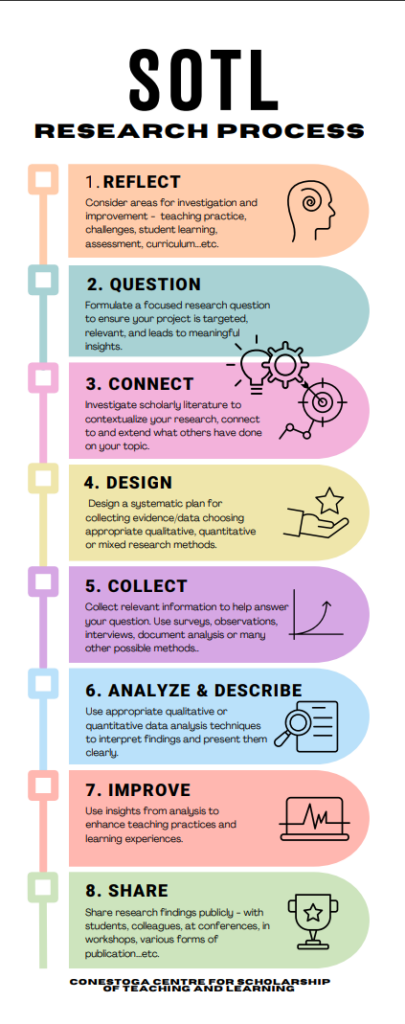
Starting Small with SoTL
Attribution for photo by David Iskander on Unsplash
Transform Your Classroom into a Learning Lab
Opportunities for SoTL exist everywhere in the educational spaces in which we work. SoTL, you ask? Previously, I introduced the Scholarship of Teaching and Learning (SoTL) as the systematic study of learning and teaching, aimed at improving student learning in classrooms across post secondary and higher education.
“[SoTL] is a kind of going meta in which faculty frame and systematically investigate questions related to student learning – the conditions under which it occurs, what it looks like, how to deepen it and so forth – and do so with an eye not only to improve their own classrooms but to advancing practice beyond it.” (Hutchings & Shulman 1999)
If you are new to SoTL, consider this: Every time you teach a course, you’re engaged in an experiment.
The syllabus is a hypothesis of our ideas about teaching a class a certain way and of students doing certain things to learn. And we assume that (hopefully) students will learn, grow, and develop as a result. Randy Bass proposed these ideas and added that most of us likely use this experimental mode in our teaching: we try things, and we expect to see certain results. Yet, our analysis of what goes on in our classrooms is often informal. For instance, based on our perceptions of how a class went, we may decide not to repeat certain activities, believe that students enjoyed what we did, or feel that we performed exceptionally well on a particular day. But how do we know for sure that something is working or not working in our classes? Or whether students are learning or not?
Bass suggests we take a more formal approach to making pedagogical decisions and designing for learning. We can achieve this by selecting an aspect of what we observe in our classroom—something we question, something that frustrates us, or something that piques our curiosity—and examining it systematically. He refers to this as closing the loop in the “experiment” of teaching a class. This is also an example of SoTL – of looking systematically, sensitively and rigorously at the evidence of student learning and asking if the assumptions we make when designing for their learning are correct. Or are there things we can and should do differently?
Wondering where to start the SoTL process?
It is common for faculty who are new to SoTL to approach it in some common ways. Many have an interest in confirming whether a strategy they want to implement in their classroom will work; others want to prove that something they’ve already tried works (Dewar & Perkins, 2021).
Reflect
If you’ve ever questioned something happening in your classroom, wondered about your students’ learning, or felt frustrated by an ongoing issue, then you have already started the SoTL process. Take this reflection, question, or idea and make it the foundation for curiosity and experimentation in your classroom. If you feel like you are starting from scratch, consider these helpful starting points:
- Examine recurring challenges: Begin with a challenge you have observed in your classroom. It could be as simple as exploring why students struggle with a particular concept.
- Get Feedback: Ask your students about their learning using an anonymous survey form. There may be an idea in there worth exploring in more depth through a SoTL project.
- Look for Patterns: Examine student work samples or track student performance over time. Identify recurring themes, challenges, or areas where improvement is needed.
- Daily Reflection: Take a few minutes each day to jot down thoughts about a class you taught, a conversation you had, or a teaching tool you explored.
There is a SoTL project in there somewhere if we view our classrooms as laboratories for learning, where every challenge is an opportunity for discovery and growth. However, ensure it is something meaningful for both your teaching development and your students’ learning. Personally, I’m not an advocate for doing research for the sake of research. This is why I love the alignment of SoTL with the applied research that our faculty and students engage in across Conestoga College. In both forms of research, the aim is to address practical problems or challenges by applying existing knowledge to solve real world problems. And there is nothing more “real world” than the interplay of complex dynamics within our classrooms that impact our students’ learning every single day.
SoTL offers a powerful process for viewing our classrooms as laboratories for learning, where every challenge is an opportunity for discovery and growth. By systematically examining our teaching practices and their impact on student learning, we can make informed, meaningful improvements that benefit both our teaching development and our students’ success. Embracing SoTL is not just about research—it’s about fostering a culture of continuous improvement and innovation in education.
References
Dewar, J., & Perkins, K. (2021). Facilitating Faculty Getting Started in SoTL: Reflections by Two Carnegie Scholars. Journal of the Scholarship of Teaching and Learning, 21(2), 107-120.
Hutchings, P., & Shulman, L. S. (1999). The scholarship of teaching: New elaborations, new developments. Change: The Magazine of Higher Learning, 31(5), 10–15.







